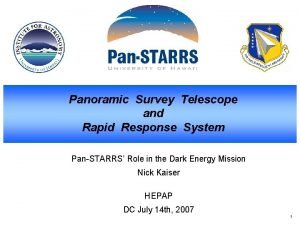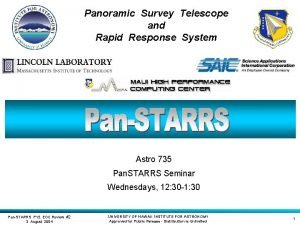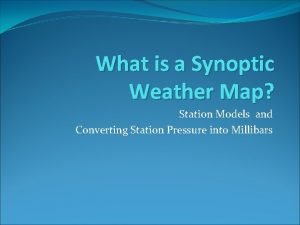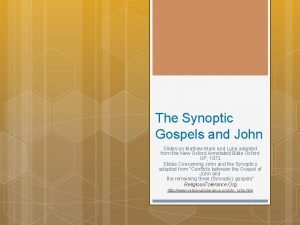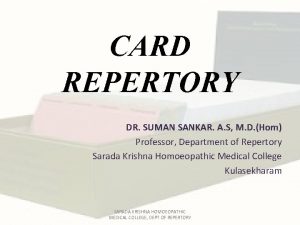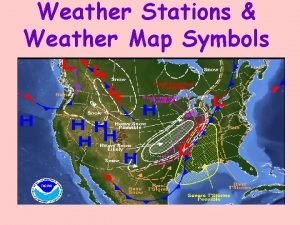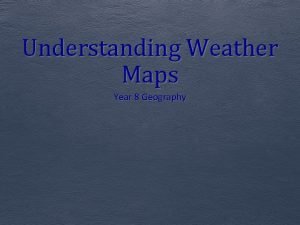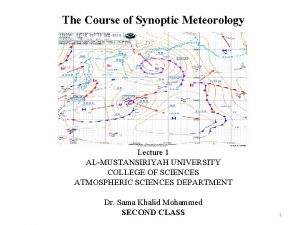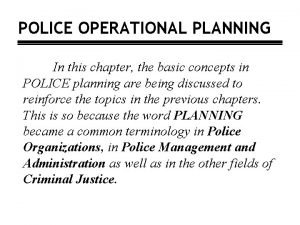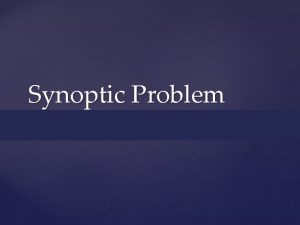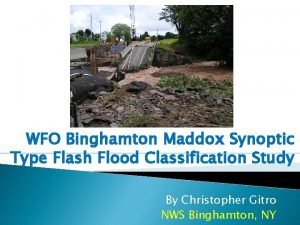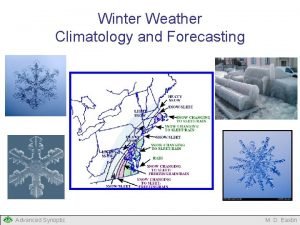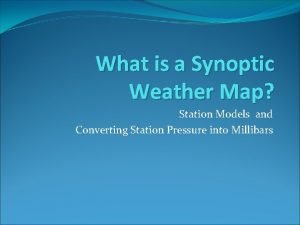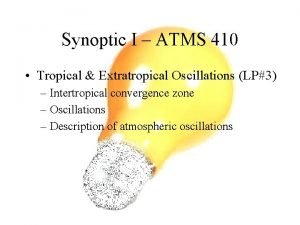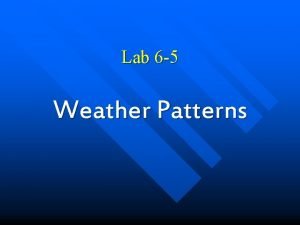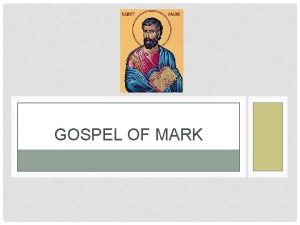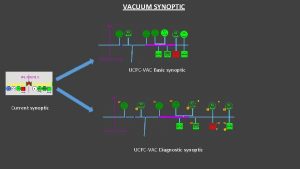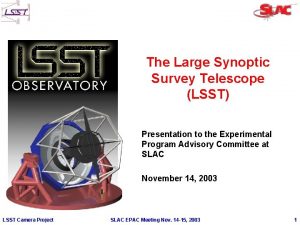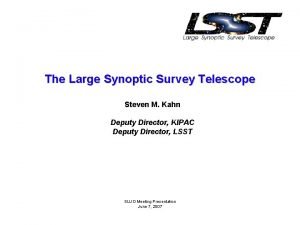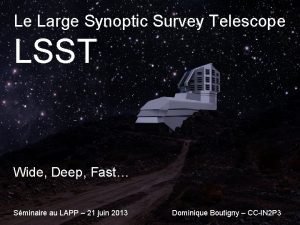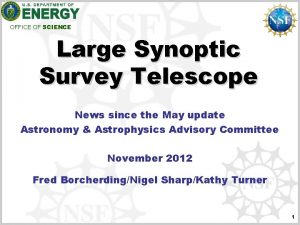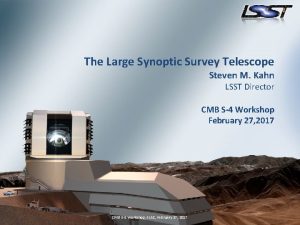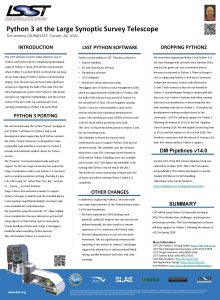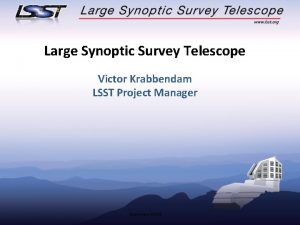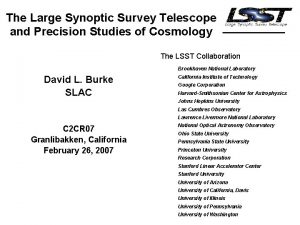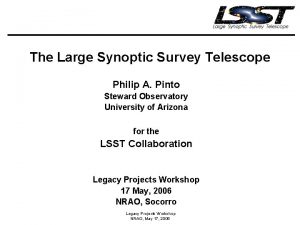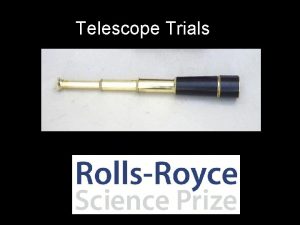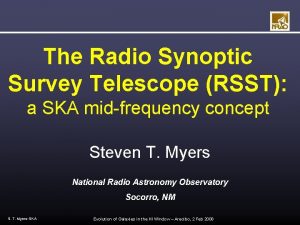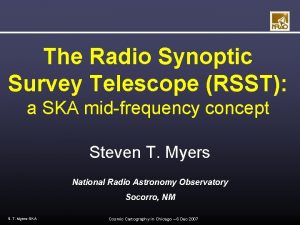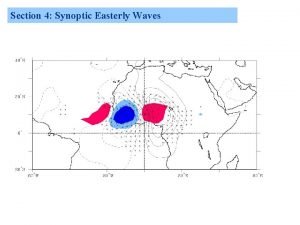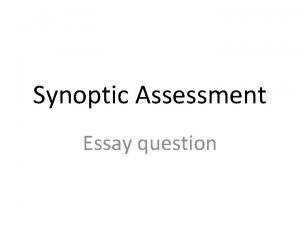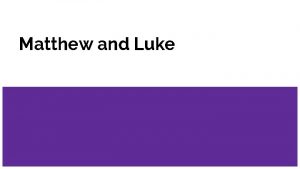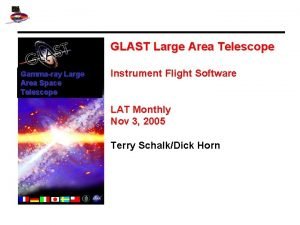The Large Synoptic Survey Telescope Presentation to AAAC






















































- Slides: 54

The Large Synoptic Survey Telescope Presentation to AAAC October 13, 2006 Anthony Tyson Director, LSST Physics Department, Univ. of California, Davis AAAC Presentation October 13, 2006

Large Synoptic Survey Telescope History: The need for a facility to survey the sky Wide, Fast and Deep, has been recognized for many years. 1996 -2000 “Dark Matter Telescope” Emphasized mapping dark matter 2000 - “LSST” Emphasized a broad range of science from the same multiwavelength survey data AAAC Presentation October 13, 2006 2

Wide+Deep+Fast: Etendue Primary mirror diameter Field of view 0. 2 degrees 10 m Keck Telescope 3. 5 degrees LSST AAAC Presentation October 13, 2006 3

LSST survey of 20, 000 sq deg • 4 billion galaxies with redshifts • Time domain: 100, 000 asteroids 1 million supernovae 1 million gravitational lenses gamma ray bursters new phenomena AAAC Presentation October 13, 2006 4

Relative Etendue (= AW) 15 sec exposures 2000 exposures per field All facilities assumed operating 100% in one survey AAAC Presentation October 13, 2006 5

Opening Time Domain AW/t AAAC Presentation October 13, 2006 6

AAAC Presentation October 13, 2006 7

LSST Survey • 6 -band Survey: ugrizy 320– 1050 nm Frequent revisits: grizy • Sky area covered: >20, 000 deg 2 0. 2 arcsec / pixel • Each 10 sq. deg FOV revisited ~2000 times • Limiting magnitude: 27. 7 AB magnitude @5 s 25 AB mag /visit = 2 x 15 seconds • Photometry precision: 0. 01 mag requirement, 0. 001 mag goal AAAC Presentation October 13, 2006

Massively Parallel Astrophysics – Dark matter/dark energy via weak lensing – – – – Dark matter/dark energy via baryon acoustic oscillations Dark energy via supernovae Dark energy via counts of clusters of galaxies Galactic Structure encompassing local group Dense astrometry over 20000 sq. deg: rare moving objects Gamma Ray Bursts and transients to high redshift Gravitational micro-lensing Strong galaxy & cluster lensing: physics of dark matter Multi-image lensed SN time delays: separate test of cosmology Variable stars/galaxies: black hole accretion QSO time delays vs z: independent test of dark energy Optical bursters to 25 mag: the unknown 5 -band 27 mag photometric survey: unprecedented volume Solar System Probes: Earth-crossing asteroids, Comets, trans. Neptunian objects AAAC Presentation October 13, 2006 9

LSST Ranked High Priority • NRC Astronomy Decadal Survey • NRC New Frontiers in the Solar System • NRC Quarks-to-Cosmos • SAGENAP • Quantum Universe • Physics of the Universe • Dark Energy Task Force + P 5 AAAC Presentation October 13, 2006 10

AAAC Presentation October 13, 2006 11

LSST Funding Timeline • FY-2004 R&D proposal to NSF AST • FY-2005 $14. 2 M LSST R&D grant • FY-2006 DOE CD-0 Ground-based dark energy • FY-2007 LSST NSF MREFC Proposal submitted • FY-2009 NSB moves LSST to readiness phase • FY-2009 DOE MIE funding begins for camera • FY-2010 NSF MREFC award to begin construction • FY-2014 First light and commissioning AAAC Presentation October 13, 2006 12

LSST Probes Dark Energy and Dark Matter ® ® ® Weak lensing (multiple probes) Baryon acoustic oscillations Counts of massive structures vs redshift Supernova cosmology (complementary to JDEM) Mass power spectrum on very large scales tests CDM paradigm Shortest scales of dark matter clumping tests models of dark matter particle physics The LSST survey will address all with a single dataset! AAAC Presentation October 13, 2006 13

AAAC Presentation October 13, 2006 14

Weak Gravitational Lensing Heritage 1983 -2000 Weak gravitational lens experiments using Blanco telescope 2000 First detection of cosmic shear 2000 -2005 Deep Lens Survey 1996 - Emerging need for an all-sky deep multi-wavelength facility with controllable systematic errors Today, several distinct groups worldwide are pursuing weak lens cosmology on a variety of telescopes. 2 -degree by 2 -degree mass map of one of five Deep Lens Survey fields. All four clusters examined in this field have been verified with spectroscopy and X-ray observations (2005) 15 AAAC Presentation October 13, 2006

20000 sq. deg WL survey shear power spectra z=1100 z=3. 2 z=3. 0 z=3. 2 z=0. 6 0. 01 shear z=0. 2 z=0. 6 0. 001 shear z=0. 2 Blanco shear systematics floor 0. 001 shear LSST shear systematics floor Require: shear error < 0. 0002 AAAC Presentation October 13, 2006 16

Addressing DETF Critical Issues ® WL Ø shear reconstruction errors Show control to better than required precision using existing new facilities Ø Photometric redshift errors Ø Develop robust photo-z calibration plan Ø Undertake world campaign for spectroscopy ® Photometry Ø errors Develop and test precision flux calibration technique AAAC Presentation October 13, 2006 17

Subaru 10 sec Exposures 13 arcmin (l = 1000) Raw de-trailed PSF corrected Single exposure in 0. 65 arcsec seeing <shear> = = 0. 04 0. 07 <shear> < 0. 0001 = 0. 000013 AAAC Presentation October 13, 2006 18

Residual Subaru Shear Correlation Test of shear systematics: Use faint stars as proxies for galaxies, and calculate the shear-shear correlation. Cosmic shear signal Compare with expected cosmic shear signal. Conclusion: 500 exposures per sky patch will yield negligible PSF induced shear systematics. Wittman (2005) AAAC Presentation October 13, 2006 19

Photometric Redshifts Calibration: angular correlation between photo-z and spectroscopic samples enables high precision photo-z: http: //www. lsst. org/Science/Phot-z-plan. pdf Precision calibration plan: underway. Likely will exceed requirements. AAAC Presentation October 13, 2006 20

12 -band Super Photo-z Training Set Using angular correlations this training set enables LSST photo-z error calibration to better than required precision Systematic error: 0. 003(1+z) calibratable Need 20, 000 spectroscopic redshifts AAAC Presentation October 13, 2006 21

Baryon Acoustic Oscillations CMB (z = 1080) BAO (z < 3) RS~140 Mpc Standard Ruler Two Dimensions on the Sky Angular Diameter Distances Three Dimensions in Space-Time Hubble Parameter AAAC Presentation October 13, 2006 22

LSST Precision on Dark Energy Zhan 2006 WL+BAO and Cluster counts give separate estimates. Both require wide sky area deep survey. AAAC Presentation October 13, 2006 23

Dark Energy Precision vs time Separate DE Probes Combined AAAC Presentation October 13, 2006 24

LSST Project Organization • The LSST is a public/private project with public support through NSFAST and DOE-OHEP. Board of Directors President John Schaefer • Private support is devoted primarily to project infrastructure and fabrication of the primary/tertiary and secondary mirrors, which are long-lead items. Director Anthony Tyson Science Advisory Steve Kahn, Deputy Committee (SAC Donald Sweeney NSF support is proposed to fund the telescope. DOE support is proposed to fund the camera. Science Working Groups Victor Krabbendam, Deputy System Scientist & • ) Michael Strauss Project Manager System Engineering Chair of Science Council William Althouse Zeljko Ivezic Ed & Pub Outreach Suzanne Jacoby Simulation & Data Philip Pinto System Calibration David Burke • Both agencies would contribute to data management and operations. Telescope/Site Data Management Steven Kahn, Sci. Camera Charles Claver, Sci. Timothy Axelrod, Sci. Kirk Gilmore, Mgr. Victor Krabbendam, Mgr. Jeffrey Kantor, Mgr. LSST Organization Chart AAAC Presentation October 13, 2006 25

The LSST Corporation • The project is overseen by the LSSTC, a 501(c)3 non-profit Arizona corporation based in Tucson. • LSSTC is the recipient of private funding, and is the Principal Investigator organization for the NSF D&D funding. AAAC Presentation October 13, 2006 26

LSSTC member institutions Brookhaven National Laboratory Harvard-Smithsonian Center for Astrophysics Johns Hopkins University Las Cumbres Observatory Lawrence Livermore National Laboratory National Optical Astronomy Observatory 16 current member institutions. Google Corp. has applied. More pending. Pennsylvania State University Research Corporation Stanford Linear Accelerator Center Stanford University of Arizona University of California, Davis + Several foreign groups. University of California, Irvine University of Illinois University of Pennsylvania University of Washington AAAC Presentation October 13, 2006

Foreign prospective members • German university group (led by Matthias Steinmetz) • French group (IN 2 P 3 Collaboration) • UK university group (led by Andrew Lawrence) • European Southern Observatory (Catherine Cesarsky, Dir) AAAC Presentation October 13, 2006

LSST integrates Astronomy & Physics communities astronomy LSST Project NSF particle physics DOE AAAC Presentation October 13, 2006 29

LSST Science Collaborations 1. Supernovae: M. Wood-Vasey (Cf. A) 2. Weak lensing: D. Wittman (UCD) and B. Jain (Penn) 3. Stellar Populations: Abi Saha (NOAO) 4. Active Galactic Nuclei: Niel Brandt (Penn State) 5. Solar System: Steve Chesley (JPL) 6. Galaxies: Harry Ferguson (STSc. I) 7. Transients/variable stars: Shri Kulkarni (Caltech) 8. Large-scale Structure/BAO: Andrew Hamilton (Colorado) 9. Milky Way Structure: Connie Rockosi (UCSC) 10. Strong gravitational lensing: Phil Marshall (UCSB) 171 signed on already, from member institutions and project team. AAAC Presentation October 13, 2006

LSST optical design has a 3. 5 o FOV, 8. 4 m primary, <0. 2 arcsec PSF from l=320 -1050 nm Secondary 64 cm focal plane 3 refractive lenses Tertiary Primary AAAC Presentation October 13, 2006 31

Mirror Designs Primary/Tertiary Mirror • • Unique Monolithic Mirror: Primary and Tertiary Surfaces Polished Into Single Substrate Cast Borosilicate Design 8. 4 Meters Primary Surface Tertiary Surface Mirror Cell (Yellow) Secondary Mirror • • Thin Meniscus Low Expansion Glass Design for Secondary Mirror 102 Support Actuators 0. 9 M Secondary Mirror Baffle (Black) AAAC Presentation October 13, 2006 32

The telescope baseline design is complete Camera and Secondary assembly Finite element analysis Carrousel dome Altitude over azimuth configuration AAAC Presentation October 13, 2006 33

The LSST carrousel dome is 30 m in diameter 30 meters AAAC Presentation October 13, 2006 34

The LSST will be on El Penon peak in Northern Chile in an NSF compound 1. 5 m photometric calibration telescope AAAC Presentation October 13, 2006 35

The LSST camera will have 3 gigapixels in a 64 cm diameter image plane Raft Tower L 3 Lens Shutter L 1/L 2 Housing Five Filters in stored location Camera Housing L 1 Lens L 2 Lens Filter in light path AAAC Presentation October 13, 2006 36

Camera body with five filters and shutter Back Flange Filter Carousel Filter Changer rail Shutter Manual Changer access port Filter Changer AAAC Presentation October 13, 2006 37

The LSST Focal Plane Wavefront Sensors (4 locations) Guide Sensors (8 locations) Wavefront Sensor Layout 2 d Focal plane Sci CCD 40 mm Curvature Sensor Side View Configuration 3. 5 degree Field of View (634 mm diameter) AAAC Presentation October 13, 2006 38

The basic building block for the camera is the raft tower 3 x 3 CCD Sensor Array Raft Assembly 4 Kx 4 K Si CCD Sensor CCD Carrier Thermal Strap(s) SENSOR Flex Cable & Thermal Straps Electronics Cage Electronics RAFT TOWER AAAC Presentation October 13, 2006 39

The LSST CCD Sensor 16 segments/CCD 200 CCDs total 3200 Total Outputs AAAC Presentation October 13, 2006 40

The LSST Data Management LSST generates 6 GB of raw data every 15 seconds that must be calibrated, processed, cataloged, indexed, and queried, etc. often in real time LSST Data Management Model Infrastructure Hardware Computers, disks, data links, , Middleware Interface wrapper Device drivers, system management, … Applications Science Image processing, database queries, … AAAC Presentation October 13, 2006 41

Data Management is a major part of the LSST mission The LSSTC partnership has DOE national labs (LLNL, SLAC, BNL), NSF centers (NCSA/UI-UC), US industry (Google, Inc. ) and academic centers (Caltech, Stanford, Harvard) to create and operate a World. Class data management center AAAC Presentation October 13, 2006 42

LSST imaging & operations simulations Sheared HDF raytraced + perturbation + atmosphere + wind + optics + pixel LSST Operations, including real weather data: coverage + depth Performance verification using Subaru 15 sec imaging AAAC Presentation October 13, 2006 43

Project Management Status • • Reference Design complete Full WBS with dictionary and task breakdown Task-based estimate complete Integrated cost/schedule complete NSF MREFC proposal for submission ~Dec’ 06 NSF Concept Design Review planned in FY 07 DOE CD-1 review planned in FY 08 AAAC Presentation October 13, 2006 44

Timeline and budget for the LSST CD-0 Fiscal Years FY-06 Submit NSF MREFC Proposal NSF and CD-2 a funding begins CD-1 51 months 2007 2008 2009 2010 2011 2012 2013 First light 2014 2015 Design and Development (and early procurement) Construction Commissioning Operations Requests (Then Year USD): NSF DOE Private/other $15 M $20 M $10 M $263 M $109 M $ 66 M $15 M/yr Escalated task-based estimate with 30% contingency AAAC Presentation October 13, 2006 45

Why Now? – Broad science community interest – Synergy with 2013 - multi-wavelength facilities – Multiple endorsements – Systematic risks addressed – Technically ready AAAC Presentation October 13, 2006 46

Q&A slides AAAC Presentation October 13, 2006 47

DE Science Drives Short Exposures • • • Weak lensing requires exquisite control of shape systematics. One needs hundreds of exposures per filter per sky patch for chopping. Short exposures allow us to optimally weight. Many exposures with sky rotated on detector permit another chop. These require high etendue and short exposures. AAAC Presentation October 13, 2006 48

Near Earth Objects • Inventory of solar system is incomplete • LSST would get orbits of nearly all NEOs larger than 140 m (per congressional mandate) • Demanding project: requires mapping the sky down to 24 th magnitude every few days, individual exposures not to exceed 15 sec • Uses same sky tiling cadence optimal for dark energy AAAC Presentation October 13, 2006 49

Difference imaging Deep Lens Survey AAAC Presentation October 13, 2006 50

Full sampling improves linking per visit LSST baseline cadence using r band data only AAAC Presentation October 13, 2006 51

Formation of our Galaxy and Group SDSS LSST AAAC Presentation October 13, 2006 52

Optical flashes difference Deep Lens Survey AAAC Presentation October 13, 2006 53

LSST will use existing NSF-funded fiber optic networks Typical data rate required ~2 GB/sec Cerro La Pachon Serena AAAC Presentation October 13, 2006 54
 Panoramic survey telescope and rapid response system
Panoramic survey telescope and rapid response system Panoramic survey telescope and rapid response system
Panoramic survey telescope and rapid response system Primary survey secondary survey
Primary survey secondary survey Wjec criminology unit 4 exam 2020
Wjec criminology unit 4 exam 2020 Synoptic weather data
Synoptic weather data Synoptic gospels
Synoptic gospels Sharma card repertory pdf
Sharma card repertory pdf Weather front symbols
Weather front symbols Understanding weather maps
Understanding weather maps Synoptic meteorology definition
Synoptic meteorology definition Steps in police operational planning
Steps in police operational planning Sunoptic gospels
Sunoptic gospels Maddox synoptic pattern
Maddox synoptic pattern Synoptic
Synoptic Synoptic weather station model
Synoptic weather station model Synoptic gospels
Synoptic gospels Ship synoptic code
Ship synoptic code List the synoptic gospels
List the synoptic gospels Balance using space
Balance using space Synoptic
Synoptic Weather patterns lab
Weather patterns lab Synoptic gospels
Synoptic gospels Bogers synoptic key
Bogers synoptic key Digital access survey
Digital access survey Hát kết hợp bộ gõ cơ thể
Hát kết hợp bộ gõ cơ thể Lp html
Lp html Bổ thể
Bổ thể Tỉ lệ cơ thể trẻ em
Tỉ lệ cơ thể trẻ em Chó sói
Chó sói Chụp phim tư thế worms-breton
Chụp phim tư thế worms-breton Bài hát chúa yêu trần thế alleluia
Bài hát chúa yêu trần thế alleluia Môn thể thao bắt đầu bằng từ chạy
Môn thể thao bắt đầu bằng từ chạy Thế nào là hệ số cao nhất
Thế nào là hệ số cao nhất Các châu lục và đại dương trên thế giới
Các châu lục và đại dương trên thế giới Công thức tính độ biến thiên đông lượng
Công thức tính độ biến thiên đông lượng Trời xanh đây là của chúng ta thể thơ
Trời xanh đây là của chúng ta thể thơ Cách giải mật thư tọa độ
Cách giải mật thư tọa độ 101012 bằng
101012 bằng độ dài liên kết
độ dài liên kết Các châu lục và đại dương trên thế giới
Các châu lục và đại dương trên thế giới Thể thơ truyền thống
Thể thơ truyền thống Quá trình desamine hóa có thể tạo ra
Quá trình desamine hóa có thể tạo ra Một số thể thơ truyền thống
Một số thể thơ truyền thống Cái miệng bé xinh thế chỉ nói điều hay thôi
Cái miệng bé xinh thế chỉ nói điều hay thôi Vẽ hình chiếu vuông góc của vật thể sau
Vẽ hình chiếu vuông góc của vật thể sau Thế nào là sự mỏi cơ
Thế nào là sự mỏi cơ đặc điểm cơ thể của người tối cổ
đặc điểm cơ thể của người tối cổ Ví dụ về giọng cùng tên
Ví dụ về giọng cùng tên Vẽ hình chiếu đứng bằng cạnh của vật thể
Vẽ hình chiếu đứng bằng cạnh của vật thể Tia chieu sa te
Tia chieu sa te Thẻ vin
Thẻ vin đại từ thay thế
đại từ thay thế điện thế nghỉ
điện thế nghỉ Tư thế ngồi viết
Tư thế ngồi viết Diễn thế sinh thái là
Diễn thế sinh thái là
